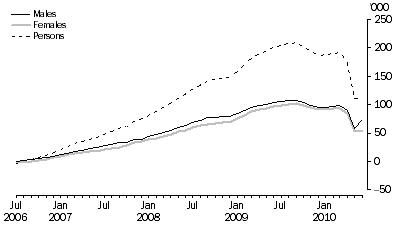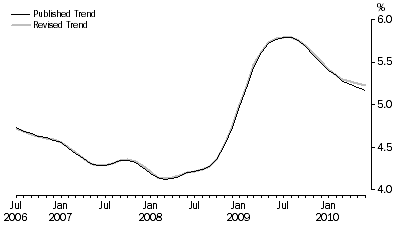CHANGES THIS MONTH
REVISED POPULATION BENCHMARKS
Labour Force Survey (LFS) estimates of persons employed, unemployed and not in the labour force are calculated to add to the estimates of the civilian population aged 15 and over (known as population benchmarks). These population benchmarks are based on Census of Population and Housing (Census) data, adjusted for under-enumeration and updated for births, deaths, interstate migration, and net overseas migration.
In March 2009, the ABS released the September 2008 issue of Australian Demographic Statistics (cat. no. 3101.0) detailing revisions to Net Overseas Migration (NOM) estimates. The revisions would normally have been included in population benchmarks underpinning the April 2009 issue of Labour Force, Australia (cat. no. 6202.0). However, due to the significance of the revisions, updating the population benchmarks using the pre-existing methodology would have introduced statistical noise into the timeseries. The decision was made to not include these revisions at that point, but to rebenchmark the series as a whole at a later date.
From this issue of Labour Force, Australia (cat. no. 6202.0) LFS estimates have been compiled using population benchmarks that incorporate revisions made to Net Overseas Migration estimates in the September 2008 and September 2009 issues of Australian Demographic Statistics (cat. no 3101.0). The revised population benchmarks apply to the months of July 2006 to June 2010.
IMPACT ON LABOUR FORCE ESTIMATES
For the period July 2006 to June 2010, the civilian population aged 15 years and over has been revised by no more or less than 1.2% in any month, in original terms. The average absolute monthly change in the civilian population benchmark for the months July 2006 to June 2010 was 112,600 persons. The largest revision to the civilian population benchmark was an increase of 210,300 persons in September 2009.
The average absolute monthly change in the male population benchmarks for the months July 2006 to June 2010 was 59,200 males. The largest revision to the male population benchmarks was an increase of 108,000 males in September 2009. The average absolute monthly change in female population benchmarks was 53,500 females, with the largest revision being an increase of 102,200 females in September 2009.
The graph below displays the revision to the civilian population for persons, males and females for the period July 2006 to June 2010.
Figure 1. Change in Civilian Population Benchmarks, Original
: July 2006 to June 2010

Revisions to the civilian population benchmarks were not uniform across age groups. The largest absolute monthly average change was to those aged 20 to 24 years, with an average absolute monthly revision of 37,600 persons. The following absolute monthly average revisions were observed for the age groups:
- 15 to 19 years revised by 10,000 persons;
- 20 to 24 years revised by 37,600 persons;
- 25 to 29 years revised by 27,500 persons;
- 30 to 34 years revised by 17,500 persons;
- 35 to 39 years revised by 8,700 persons;
- 40 to 44 years revised by 5,500 persons;
- 45 to 49 years revised by 2,900 persons;
- 50 to 54 years revised by 2,000 persons;
- 55 to 59 years revised by 1,400 persons;
- 60 to 64 years revised by 900 persons;
- 65 to 69 years revised by 600 persons; and
- 70 years and over revised by 2,900 persons.
EMPLOYED PERSONS
The absolute monthly average revision to the employed persons estimate, was larger than the revision to the civilian population.This is due to age compositional effects of the revisions made to Net Overseas Migration estimates.
Employed persons, in trend terms, was revised by an average absolute monthly change of 86,200 persons. The largest revision to the employed persons estimate was an increase of 151,800 persons in August 2009.
Figure 2. Employed Persons, Trend
: July 2006 to June 2010

UNEMPLOYED PERSONS
Unemployed persons, in trend terms, was revised by an average absolute monthly change of 6,000 persons. The largest revision to the unemployed persons estimate was an increase of 15,200 persons in June 2010.
Figure 3. Unemployed Persons, Trend
: July 2006 to June 2010

UNEMPLOYMENT RATE
The unemployment rate, in trend terms, was revised by an average absolute monthly change of 0.01 percentage points. The largest revision to the unemployment rate was an increase of 0.07 percentage points in June 2010.
Figure 4. Unemployment Rate, Trend
: July 2006 to June 2010

PARTICIPATION RATE
In trend terms, the participation rate was revised by an average absolute monthly change of 0.10 percentage points. This is due to the age composition effects referred to earlier. The largest revision to the participation rate was an increase of 0.19 percentage points in June 2010.
Figure 5. Participation Rate, Trend
: July 2006 to June 2010

AVAILABILITY OF DATA
Published and revised trend data used to compile the graphs in this article, together with the corresponding seasonally adjusted data is available on the ABS website in
Labour Force, Australia (cat. no. 6202.0) as a spreadsheet titled
Article_July2010 in the downloads tab.
ANNUAL SEASONAL REANALYSIS
As a result of the revisions outlined above, a reanalysis has been conducted on all seasonally adjusted LFS series. This reanalysis examines series for trend breaks, seasonal breaks, and outliers. (Note: this process normally takes place in February of each year, however, was delayed until revised population benchmarks were available).
FURTHER INFORMATION
For any queries regarding the implementation of any of these changes to the LFS, contact Labour Force Estimates on Canberra 02 6252 6525, or via email at labourforce@abs.gov.au.
 Print Page
Print Page
 Print All
Print All
 Quality Declaration
Quality Declaration